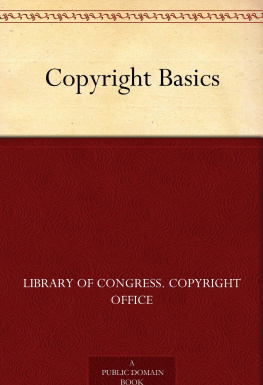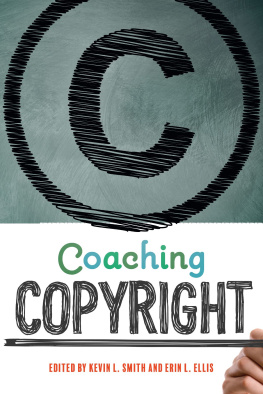Library Of Congress Copyright Office - Copyright Basics
Here you can read online Library Of Congress Copyright Office - Copyright Basics full text of the book (entire story) in english for free. Download pdf and epub, get meaning, cover and reviews about this ebook. year: 2010, publisher: General Books LLC, genre: Romance novel. Description of the work, (preface) as well as reviews are available. Best literature library LitArk.com created for fans of good reading and offers a wide selection of genres:
Romance novel
Science fiction
Adventure
Detective
Science
History
Home and family
Prose
Art
Politics
Computer
Non-fiction
Religion
Business
Children
Humor
Choose a favorite category and find really read worthwhile books. Enjoy immersion in the world of imagination, feel the emotions of the characters or learn something new for yourself, make an fascinating discovery.
- Book:Copyright Basics
- Author:
- Publisher:General Books LLC
- Genre:
- Year:2010
- Rating:4 / 5
- Favourites:Add to favourites
- Your mark:
- 80
- 1
- 2
- 3
- 4
- 5
Copyright Basics: summary, description and annotation
We offer to read an annotation, description, summary or preface (depends on what the author of the book "Copyright Basics" wrote himself). If you haven't found the necessary information about the book — write in the comments, we will try to find it.
Copyright Basics — read online for free the complete book (whole text) full work
Below is the text of the book, divided by pages. System saving the place of the last page read, allows you to conveniently read the book "Copyright Basics" online for free, without having to search again every time where you left off. Put a bookmark, and you can go to the page where you finished reading at any time.
Font size:
Interval:
Bookmark:
The Project Gutenberg EBook of Copyright Basics, byLibrary of Congress. Copyright Office. and United States
This eBook is for the use of anyone anywhere at no cost and withalmost no restrictions whatsoever. You may copy it, give it away orre-use it under the terms of the Project Gutenberg License includedwith this eBook or online at www.gutenberg.net
Title: Copyright Basics
Author: Library of Congress. Copyright Office.
United States
Posting Date: August 8, 2009 [EBook #4292]Release Date: July, 2003First Posted: December 30, 2001
Language: English
*** START OF THIS PROJECT GUTENBERG EBOOK COPYRIGHT BASICS ***
Produced by George Davis
Copyright Basics (Circular 1)
U.S. Copyright Office - Library of Congress
Copyright Basics
September 2000
Copyright Basics
(See Format Note at end of document.)
+ What Is Copyright?
+ Who Can Claim Copyright
+ Copyright and National Origin of the Work
+ What Works Are Protected?
+ What Is Not Protected by Copyright?
+ How to Secure Copyright
+ Publication
+ Notice of Copyright
+ Form of Notice for Visually Perceptible Copies
+ Form of Notice for Phonorecords of Sound Recordings
+ Position of Notice
+ Publications Incorporating U.S. Government Works
+ Unpublished Works
+ Omission of Notice and Errors in Notice
+ How Long Copyright Protection Endures
+ Transfer of Copyright
+ Termination of Transfers
+ International Copyright Protection
+ Copyright Registration
+ Registration Procedures
+ Original Registration
+ Special Deposit Requirements
+ Unpublished Collections
+ Effective Date of Registration
+ Corrections and Amplifications of Existing Registrations
+ Mandatory Deposit for Works Published in the United States
+ Use of Mandatory Deposit to Satisfy Registration Requirements
+ Who May File an Application Form?
+ Application Forms
+ Fill-in Forms
+ Fees
+ Search of Copyright Office Records
+ For Further Information
Copyright is a form of protection provided by the laws of the UnitedStates (title 17, U.S. Code) to the authors of "original works ofauthorship", including literary, dramatic, musical, artistic, andcertain other intellectual works. This protection is available to bothpublished and unpublished works. Section 106 of the 1976 Copyright Actgenerally gives the owner of copyright the exclusive right to do and toauthorize others to do the following:
+ *To reproduce* the work in copies or phonorecords;
+ To prepare *derivative works* based upon the work;
+ *To distribute copies or phonorecords* of the work to the public by
sale or other transfer of ownership, or by rental, lease, or
lending;
+ To perform the work publicly, in the case of literary, musical,
dramatic, and choreographic works, pantomimes, and motion pictures
and other audiovisual works;
+ *To display the copyrighted work publicly*, in the case of literary, musical, dramatic, and choreographic works, pantomimes, and pictorial, graphic, or sculptural works, including the individual images of a motion picture or other audiovisual work; and
+ In the case of *sound recordings, to perform the work publicly* by means of a *digital audio transmission*.
In addition, certain authors of works of visual art have the rights ofattribution and integrity as described in Title 17, Chap 1, Section 106a(Circular 92) of the 1976 Copyright Act. For further information,request "Copyright Registration for Works of the Visual Arts"[http://www.loc.gov/copyright/circs/circ40.pdf].
It is illegal for anyone to violate any of the rights provided by thecopyright law to the owner of copyright. These rights, however, are notunlimited in scope. Title 17, Chap 1 of the 1976 Copyright Actestablish limitations on these rights. In some cases, these limitationsare specified exemptions from copyright liability. One major limitationis the doctrine of "fair use", which is given a statutory basis in Title17, Chap1, Section 107 of the 1976 Copyright Act. In other instances,the limitation takes the form of a "compulsory license" under whichcertain limited uses of copyrighted works are permitted upon payment ofspecified royalties and compliance with statutory conditions. Forfurther information about the limitations of any of these rights,consult the copyright law or write to the Copyright Office.
WHO CAN CLAIM COPYRIGHT
Copyright protection subsists from the time the work is created in fixedform. The copyright in the work of authorship *immediately* becomes theproperty of the author who created the work. Only the author or thosederiving their rights through the author can rightfully claim copyright.
In the case of works made for hire, the employer and not the employee isconsidered to be the author. Title 17, Chap 1, Sec. 101 of thecopyright law defines a "work made for hire" as:
+ (1) a work prepared by an employee within the scope of his or her employment; or
+ (2) a work specially ordered or commissioned for use as:
+ a contribution to a collective work
+ a part of a motion picture or other audiovisual work
+ a translation
+ a supplementary work
+ a compilation
+ an instructional text
+ a test
+ answer material for a test
+ a sound recording
+ an atlas
if the parties expressly agree in a written instrument signed by themthat the work shall be considered a work made for hire.
The authors of a joint work are co-owners of the copyright in the work,unless there is an agreement to the contrary.
Copyright in each separate contribution to a periodical or othercollective work is distinct from copyright in the collective work as awhole and vests initially with the author of the contribution.
Two General Principles
+ Mere ownership of a book, manuscript, painting, or any other copy or phonorecord does not give the possessor the copyright. The law provides that transfer of ownership of any material object that embodies a protected work does not of itself convey any rights in the copyright.
+ Minors may claim copyright, but state laws may regulate the business dealings involving copyrights owned by minors. For information on relevant state laws, consult an attorney.
COPYRIGHT AND NATIONAL ORIGIN OF THE WORK
Copyright protection is available for all unpublished works, regardlessof the nationality or domicile of the author. Published works areeligible for copyright protection in the United States if *any* one ofthe following conditions is met:
+ On the date of first publication, one or more of the authors is a national or domiciliary of the United States, or is a national, domiciliary, or sovereign authority of a treaty party,* or is a stateless person wherever that person may be domiciled; or *A treaty party is a country or intergovernmental organization other than the United States that is a party to an international agreement.
+ The work is first published in the United States or in a foreign nation that, on the date of first publication, is a treaty party. For purposes of this condition, a work that is published in the United States or a treaty party within 30 days after publication in a foreign nation that is not a treaty party shall be considered to be first published in the United States or such treaty party, as the case may be; or
+ The work is a sound recording that was first fixed in a treaty party; or
+ The work is a pictorial, graphic, or sculptural work that is incorporated in a building or other structure, or an architectural work that is embodied in a building and the building or structure is located in the United States or a treaty party; or
+ The work is first published by the United Nations or any of its
specialized agencies, or by the Organization of American States; or
Font size:
Interval:
Bookmark:
Similar books «Copyright Basics»
Look at similar books to Copyright Basics. We have selected literature similar in name and meaning in the hope of providing readers with more options to find new, interesting, not yet read works.
Discussion, reviews of the book Copyright Basics and just readers' own opinions. Leave your comments, write what you think about the work, its meaning or the main characters. Specify what exactly you liked and what you didn't like, and why you think so.











